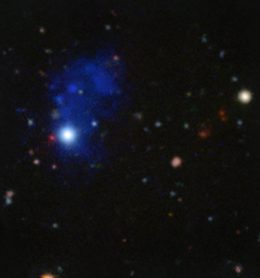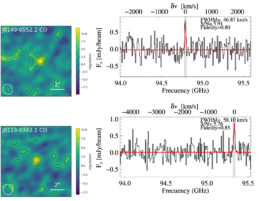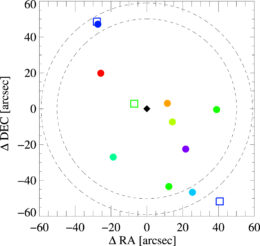How can we trace the formation of structure in the early universe? A new article surveys the environments around massive galaxies that existed less than two billion years after the Big Bang to learn more.
Questing for Quasars

A cloud of gas surrounds the distant quasar SDSS J102009.99+104002.7 in this image from ESO’s Very Large Telescope. The name “quasar” is a shortening of “quasi-stellar radio source”, though we now know that only a small fraction of quasars are radio-loud. [ESO/Arrigoni Battaia et al.; CC BY 4.0]
Past studies have explored this hypothesis, but the results have been conflicting. Some studies have found that quasars have an abundance of galaxies in their vicinity, while others have found that there are no more galaxies than to be expected if they were randomly scattered throughout space. There are many potential reasons for this disagreement, including the possibility that dust hides these distant galaxies from the searching eyes of optical telescopes. In a new article, a team led by Cristina García-Vergara (Leiden Observatory, The Netherlands) approached this question in a new way — by using a massive array of radio telescopes to peer through the dust.

Sample emission line maps (left column) and spectra extracted from each source’s brightest pixel (right column) for the sources detected in this work. Click to enlarge. [Adapted from García-Vergara et al. 2022]
Long Wavelengths and Large Distances
García-Vergara and collaborators observed the areas surrounding 17 quasars with redshifts of z ~ 4 (roughly 1.6 billion years after the Big Bang) with the Atacama Large Millimeter/submillimeter Array (ALMA) — a collection of 66 radio telescopes working together as one. The team sought emission from a particular spectral line of carbon monoxide, which can signal the presence of a galaxy even if it is so shrouded in dust that it would be invisible at optical wavelengths.
Using a search algorithm, García-Vergara and collaborators identified all the sources of carbon monoxide emission in each quasar’s vicinity, finding a total of nine carbon monoxide-line-emitting galaxies among the 17 fields they searched. As is often important when studying sources billions of light-years away, the team also assessed the likelihood that the sources they detected are actually galaxies in the local universe masquerading as galaxies in the early universe and found it unlikely.
Galactic Neighbors

Distribution of the nine carbon monoxide sources (filled symbols) for all 17 quasar fields combined. The black diamond at the center indicates the location of the quasar, and the empty symbols indicate the locations of Lyman-alpha emitting galaxies from a previous study. [García-Vergara et al. 2022]
Not only are there more galaxies than expected, they’re also tightly clustered around the quasars. These two pieces of evidence strongly support the idea that quasars are tracers of massive structures forming early in the universe, though the authors note that the statistical significance of their result could be improved by pushing the observations deeper or wider — hopefully the future will bring new observations and a fresh perspective on galaxies in the early universe!
Citation
“ALMA Reveals a Large Overdensity and Strong Clustering of Galaxies in Quasar Environments at z ∼ 4,” Cristina García-Vergara et al 2022 ApJ 927 65. doi:10.3847/1538-4357/ac469d
